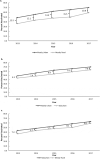Trends in human papillomavirus (HPV) vaccination initiation among adolescents aged 13-17 by metropolitan statistical area (MSA) status, National Immunization Survey - Teen, 2013 - 2017
- PMID: 31662024
- PMCID: PMC7227639
- DOI: 10.1080/21645515.2019.1671765
Trends in human papillomavirus (HPV) vaccination initiation among adolescents aged 13-17 by metropolitan statistical area (MSA) status, National Immunization Survey - Teen, 2013 - 2017
Abstract
Disparities in HPV vaccination coverage by metropolitan statistical area (MSA) status were observed in the 2016 and 2017 National Immunization Survey - Teen (NIS-Teen). In 2017, HPV vaccination initiation (≥1dose) coverage was 11 percentage points lower for adolescents living in non-MSAs (mostly rural areas) and 7 percentage points lower among those living in MSA, non-principal cities (suburban areas) compared to those living in MSA, principal cities (mostly urban areas). In order to understand how this disparity has changed over time, we examined trends in HPV vaccine initiation by MSA status from 2013 to 2017. Weighted linear regression by survey year was used to estimate annual percentage point changes in HPV vaccination initiation. The five-year average annual percentage point increases in HPV vaccination initiation coverage were 5.2 in mostly urban areas, 4.9 for suburban areas, and 5.2 for mostly rural areas. Despite increases in each MSA area, coverage in mostly rural areas was consistently and significantly lower than coverage in mostly urban areas. Coverage was significantly lower among teens living in mostly rural areas regardless of poverty status, sex, and race/ethnicity except among black, non-Hispanic adolescents. There was no significant change in the magnitude of the disparity between mostly urban areas and mostly rural areas over time (p = .98). A better understanding of the facilitators and barriers to HPV vaccination in mostly rural areas is needed to identify and implement targeted strategies to improve HPV vaccination coverage and reduce these disparities.
Keywords: Human papillomavirus (HPV) vaccine; adolescents; disparity; rural; trend; urban.
Figures




Similar articles
-
Factors associated with not receiving HPV vaccine among adolescents by metropolitan statistical area status, United States, National Immunization Survey-Teen, 2016-2017.Hum Vaccin Immunother. 2020 Mar 3;16(3):562-572. doi: 10.1080/21645515.2019.1670036. Epub 2019 Oct 25. Hum Vaccin Immunother. 2020. PMID: 31584312 Free PMC article.
-
Area-based socioeconomic factors and Human Papillomavirus (HPV) vaccination among teen boys in the United States.BMC Public Health. 2017 Jul 14;18(1):19. doi: 10.1186/s12889-017-4567-2. BMC Public Health. 2017. PMID: 28709420 Free PMC article.
-
National, Regional, State, and Selected Local Area Vaccination Coverage Among Adolescents Aged 13-17 Years - United States, 2017.MMWR Morb Mortal Wkly Rep. 2018 Aug 24;67(33):909-917. doi: 10.15585/mmwr.mm6733a1. MMWR Morb Mortal Wkly Rep. 2018. PMID: 30138305 Free PMC article.
-
Race, ethnicity, and income factors impacting human papillomavirus vaccination rates.Clin Ther. 2014 Jan 1;36(1):24-37. doi: 10.1016/j.clinthera.2013.11.001. Clin Ther. 2014. PMID: 24417783 Review.
-
Race, ethnicity and income as factors for HPV vaccine acceptance and use.Hum Vaccin Immunother. 2013 Jul;9(7):1413-20. doi: 10.4161/hv.24422. Epub 2013 Apr 9. Hum Vaccin Immunother. 2013. PMID: 23571170 Review.
Cited by
-
The prevalence of human papillomavirus vaccination among racial and ethnic minority adolescents during the COVID-19 pandemic.JNCI Cancer Spectr. 2023 Aug 31;7(5):pkad065. doi: 10.1093/jncics/pkad065. JNCI Cancer Spectr. 2023. PMID: 37651597 Free PMC article.
-
Barriers and facilitators to HPV vaccination in rural South Carolina pharmacies: a qualitative investigation.Implement Sci Commun. 2025 Mar 20;6(1):26. doi: 10.1186/s43058-025-00711-2. Implement Sci Commun. 2025. PMID: 40114254 Free PMC article.
-
An Ecological Analysis of HPV Vaccination in the United States Before and During the COVID-19 Pandemic by Age, Sex, and Urbanicity Using Private Insurance Claims Data.Cancer Med. 2025 Mar;14(6):e70761. doi: 10.1002/cam4.70761. Cancer Med. 2025. PMID: 40116295 Free PMC article.
-
Demographic, psychological, and experiential correlates of SARS-CoV-2 vaccination intentions in a sample of Canadian families.Vaccine X. 2021 Aug;8:100091. doi: 10.1016/j.jvacx.2021.100091. Epub 2021 Mar 22. Vaccine X. 2021. PMID: 33778480 Free PMC article.
-
A Survey of Teachers' Status in Mental Health Education Management Based on Big Data Analysis.Occup Ther Int. 2022 Sep 21;2022:8399938. doi: 10.1155/2022/8399938. eCollection 2022. Occup Ther Int. 2022. Retraction in: Occup Ther Int. 2023 Aug 16;2023:9847923. doi: 10.1155/2023/9847923. PMID: 36212086 Free PMC article. Retracted.
References
-
- Markowitz LE, Dunne EF, Saraiya M, Chesson HW, Curtis CR, Gee J, Bocchini JA Jr, Unger ER. Human papillomavirus vaccination: recommendations of the Advisory Committee on Immunization Practices (ACIP). Morb. Mortal. Wkly. Rep: Recommendations Rep. 2014;63:1–30. - PubMed
-
- Centers for Disease Control and Prevention (CDC). Recommendations on the use of quadrivalent human papillomavirus vaccine in males–Advisory Committee on Immunization Practices (ACIP) . 2011. MMWR Morb Mortal Wkly Rep. 2011;60(50):1705. - PubMed
MeSH terms
Substances
LinkOut - more resources
Full Text Sources
Medical
